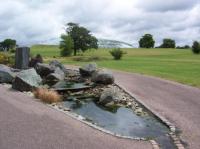The National Botanic Gardens of Wales

Our visit to the National Botanic Gardens of Wales.
The week before last, as part of a family holiday in South Wales we visited the National Botanic Gardens of Wales. Located a few miles to the east of Carmarthen the gardens are suitable to visit even if the weather is not particularly kind; on the day we went it was quite wet but we still enjoyed our visit.
First impressions are very important, on arrival at the gardens I knew we were in for a horticultural treat simply by the care of and variety of planting in the car park. An Acer rubrum ‘October Glory’ particularly caught my eye, although I was surprised to see it in almost full autumn colour in the middle of August; global warming I suppose.
On entering the gardens we began our walk up The Broadway. Our children ran towards the first of 7 lakes in the gardens to see the ducks and coots. The Botanic Gardens of Wales are in the process of restoring these 200 year old lakes to their former glory. They were drained during the Second World War because German bombers were using them as a landmark on their approach to bomb Swansea and Port Talbot. Three lakes have been restored so far since the Botanic Gardens took ownership of the land.
As we continued our walk up The Broadway, heading for the Great Glasshouse the children enjoyed the water features and fountains, whilst I admired the planting. The bright orange blooms of Crocosmia ‘Spitfire’ particularly caught my eye.
At the bottom of the slopes of the Great Glasshouse we discovered the Bog Garden. This garden was designed to catch the water running of the slopes. In addition to the Welsh weather and the local clay soil the water run off has helped to create an ideal site for moisture loving plants. The Gunnera was particularly impressive with it’s 6ft wide leaves encroaching on to the boardwalk through the Bog Garden.
After our short detour into the bog garden we continued up the Broadwalk to the Great Glasshouse. Dominating the gardens, but with subtle grace and beauty the Great Glasshouse is probably and understandably the highlight of most people’s visit.
Entering the Great Glasshouse is just amazing, it feels like walking into a huge spaceship. The glasshouse is the largest single-span glasshouse in the world. It is home to a collection of plants that have been planted with the aim of giving visitors a ‘naturalistic Mediterranean experience’.
The wheelchair and pushchair friendly pathways through the glasshouse guide visitors through a living education in the diversity of the different regions of the world that have a Mediterranean climate and the flora that they each sustain. The 5 regions of the world that have a Mediterranean climate are S.W. Australia, coastal California, coastal Chile, the Cape province of S. Africa and the Mediterranean basin including the Canary Islands. Each of these areas of the world are represented in the Great Glasshouse, together with the variety of conditions within the region e.g. wet areas or gravel/boulder environments.
Many of the plants you come across in the glasshouse are very rare in their natural habitats, they have been selected to be grown in the glasshouse to provide ‘education, conservation and enjoyment’.
Our Mediterranean experience over, we headed for the Walled Garden where we enjoyed the Dahlias, the variegated Phlox paniculata ‘Becky Towe’ and the different varieties of Alstromeria.
Pressing on, after a brief stop in the ‘Roots and Shoots’ children’s outdoor play area we came across the Walled Kitchen Garden. Of particular interest and amazement here was the allotment area for local schools. In particular a greenhouse under construction rivalled the Great Glasshouse in it’s design. Whoever thought of this idea was very clever; a greenhouse made of 2 litre soft drinks bottles inter-linked with one another, supported by wire and a wooden structure. I thought it was a brilliant recycling idea and would be interested to find out how much light the bottles would let through in comparison to glass or polythene.
The penultimate area of the gardens that we visited was the Japanese Garden. It was a classic example of Japanese garden design with large rocks, gravel, still and moving water and bamboo perimeters all complimented by native Japanese plants, the Maples leading the way. I was interested to see that the Japanese Garden had been designed by Professor Fukuhara, who taught me a lot about Japanese garden design when we did some work together on the Japanese Gateway Garden at the Royal Botanic Gardens, Kew.
Our visit to the National Botanic Gardens of Wales concluded with a visit to the Bee Garden. Our sons aged 3 and 5 particularly enjoyed this one. You get quite up close and personal with the bees, you are protected by an enclosed glass screen that incorporates live TV monitors on some of the entrances to the 20 hives in the garden. As well as the hives, the bee garden is planted with lots of plants that attract bees and provide a rich source of pollen for them. As well as being fun, the bee garden was very educational and made us think about how important it was to sustain and improve the bee population in our own garden.
Despite the weather, a thoroughly enjoyable visit to the National Botanic Gardens of Wales, I would highly recommend it.
For more information see:
The National Botanic Gardens of Wales
Filed under Reviews.
